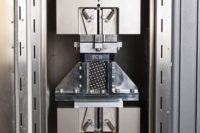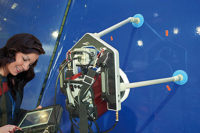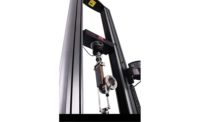Characterization of the properties of anisotropic and inhomogeneous composite materials for use in demanding structural applications requires a wide range of mechanical tests. Furthermore, tests need to be conducted over a range of temperatures on materials conditioned in a variety of different environmental conditions. The measurement of strain is a key requirement in tests to determine and monitor tension, compression, and shear properties.
Currently, most approaches to strain measurement in composites coupon testing use contacting methods involving bonded strain gages or clip-on extensometers. Recent developments in noncontacting strain measurement mean these systems now offer similar performance to traditional contacting systems, as well as providing significant other benefits such as the ability to provide full field strain maps.
TECH TIPSStrain gages and contacting extensometers will continue to have a major role is composites testing. Generally, extensometers are preferred because of their ease of use and lower costs; however, there are situations where strain gages are still required. Noncontact strain measurement systems now offer accuracies similar to traditional contacting extensometers whilst providing practical advantages in terms of operation and robustness. |
General Aspects of Strain Measurement for Coupon Testing
Measurement of axial strain in tension tests can be achieved using a single strain measurement on one side of the specimen; however, more consistent and accurate results can be achieved by using the average of a pair of measurements on opposite sides of the test specimen, in order to compensate for the effects of bending due to misalignment. For compression testing the use of an average strain value derived from measurements on opposite sides of the specimen is required by most standards.
In principle, since the strains in tension and compression test specimens are generally uniform, so either local strain can be measured using a strain gage or an average strain over an extended gage length can be measured using an extensometer. In some cases the small size of the specimen gage section used in unsupported compression tests may prevent the use of extensometers and require the use of strain gages.
Tests to determine shear properties (e.g. in plane shear, rail shear, and vee-notch shear tests) require the measurement of shear strain. Shear strain can be determined from measurements of axial and transverse strain. In vee-notch shear tests the strain distributions are non-uniform with the strain being concentrated between the notches; accurate measurements of these local strains requires the use of strain gages.
Strain gages
Bonded strain gages are still widely used to measure the strain in composite coupons. The strain gages in common use consist of thin metal foil grids mounted on an insulating backing and their operation relies on the change in resistance of an electrical conductor subject to an applied strain. The changes in the resistance of a strain gage at the strain levels encountered in composites testing (typically 3%) is small and specialist strain gage conditioning electronics is required to provide accurate measurements. The sensitivity of the gage (known as the gage factor) is required in order for the correct calibration of the measurement system; this information is provided by the manufacturer of the gages. In order to make accurate measurements, strain gages must be correctly aligned and carefully bonded to the surface of test specimens (with specimens that have been wet conditioned, this can be difficult).
Strain gages are mainly sensitive to strains in the direction parallel to gage grid; however, they are also somewhat sensitive to transverse strains i.e. strains at right angle to the grid and, when testing composite materials with wide variations in Poisson’s ratio, this can cause significant errors. Strain gages are available in a variety of forms as either single gage or as pre-aligned gage combinations known, generically, as rosettes. Foil strain gages can be used over a range of temperatures from cryogenic to over 200 C.
Although strain gages can provide very accurate strain measurements, they are a consumable item and are costly in terms of both materials and the skilled labor needed to apply them.
Clip-on Extensometers
Clip-on extensometers are widely used in the testing of composites coupons. They are designed to attach to the coupon and measure engineering strain by determining displacement over a fixed gage length. For composites testing, the most commonly used gage lengths are 25 mm and the maximum strain is generally less than 5%.
Most clip-on extensometers use strain gaged flexures to measure displacement, these extensometers can be used from cryogenic temperatures to about 200 C. Operation above 200 C requires either some form of cooling (e.g. water or air) or the use of a transducer capable of operating at the test temperature. An example of a high-temperature extensometer employing a capacitive sensor and capable of operating at up to 600 C is shown in Figure 1.
In addition to single axial clip-on extensometers a number of other types of extensometers are commonly used for composites testing.
The averaging axial clip-on extensometer uses a pair of axial extensometers positioned on either side of the specimen. The measurements from the extensometers are then averaged. The measurement of average axial strain eliminates strain measurement errors arising from the presence of bending in the test specimen caused by alignment errors in the load string.
Measurement of shear strains and Poisson’s ratio requires the simultaneous measurement of axial and transverse strain. Transverse clip-on extensometers are similar in design to axial types but they measure the change in width of the test specimen. Biaxial extensometers, which integrate both axial and transverse extensometers in to a single unit, are available and these units are more convenient to attach than two separate extensometers. An example of a biaxial extensometer is shown in Figure 2.
Clip-on extensometers can provide accurate strain measurements and are very cost effective when compared to strain gages; however they do require careful handling and attachment. With any type of clip-on extensometer the effect of energetic specimen breaks on the long term reliability of the extensometer should be considered and, if possible, the extensometer should be removed from the specimen prior to failure.
Automatic Extensometers
Automatic extensometers are contacting types incorporating remote control of many or all of the extensometer functions. These extensometers are used within a wide application range of high-volume tensile testing and are an essential part of many fully-automated (robotic) testing systems. Automatic extensometers have a set of arms that contact the specimen and link directly to a high-accuracy linear measurement transducer. Typically an automatic extensometer will be provided with an ability to engage and disengage from a test specimen and change the gage length. An example of an automatic extensometer is shown in Figure 3.
Use of an automatic extensometer reduces the influence of the operator and improves the consistency of test results. Automatic extensometers are also more robust than clip-on types and can be automatically removed from the test specimen prior to failure.
Noncontact Video Extensometers
Noncontact video extensometers utilize high-resolution digital cameras and real-time image processing to track the movement of contrasting marks on a test coupon. Strain is determined from the change in the distance between the marks divided by the initial mark separation.
As mentioned earlier in this article, a high proportion of composites coupon testing is performed at non-ambient temperatures with the coupon and test fixtures located inside a temperature chamber. One of the key advantages of a noncontact approach to strain measurement is having the camera located outside the chamber viewing the specimen through a window, keeping the measurement system isolated from the hostile environment (Figure 4).
Video image based measurement systems need to include suitable illumination in order to eliminate the influence of changes in ambient illumination on the measurement. Means of calibration are also required to correct for optical distortions (e.g. from lenses or chamber windows). An effective calibration method is the use of a precision grid target
Along with automatic extensometers, noncontact video extensometers reduce the influence of the operator improving the consistency of test results. The absence of contact with the coupon means that there is no possibility of the extensometer influencing the material behavior or of the extensometer being damaged by the energy released when the coupon fails.
Full-Field Strain Measurement
An exciting development in noncontact strain measurement is the availability of systems capable of measuring full-field strain distributions. The most widely used approach to full-field strain measurement is digital image correlation (DIC). This technique works by applying a random pattern to the surface of a test specimen, capturing a series of images of a specimen during a test and then analyzing the images with an algorithm that determines first the displacement field and then the strain field for each image. The number of images captured during a test depends on time, speed, and the sample, but between 50 and 100 images are usually adequate.
The first image—also known as the reference image—is captured when there is no strain on the sample. The image is then split into small subsets and the patterns within each subset of subsequent images are compared to the reference image and displacements are calculated. From these displacements, a strain map is calculated. The strain maps of all the strain components (axial, transverse, shear strain), along with maximum and minimum normal strains can be determined. Example strain maps for an open hole composite tensile test coupon are shown in Figure 5.
Even efficient DIC algorithms require a large amount of computing power and it is not possible to perform the analysis in real time i.e. during the test—the usual approach is to acquire and store the images during the test and then perform the analysis after the test. One challenge when using DIC systems with testing machines that incorporate other measurement systems (force, displacement, and temperature) is how to synchronize and record all of the test data. One recent, integrated DIC system for use with material testing machines has solved this problem by synchronizing the recording of the images and the other test data digitally.
Compared to traditional methods of local strain (e.g. strain gages) or average strain over a large gage length (e.g. extensometers) measurement, full-field strain measurement yields an enormous amount of additional information that can help engineers and scientists better understand material behavior.
Conclusion
Strain gages and contacting extensometers will continue to have a major role in composites testing. Generally, extensometers are preferred because of their ease of use and lower costs; however, there are situations where strain gages are still required.
Noncontact strain measurement systems now offer accuracies similar to traditional contacting extensometers whilst providing practical advantages in terms of operation and robustness. Furthermore, the availability of noncontact full-field strain measurement tools is opening up new ways of understanding the behavior of composite materials.








